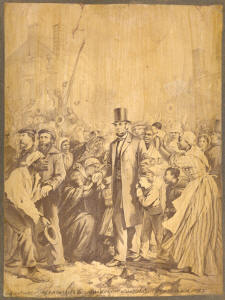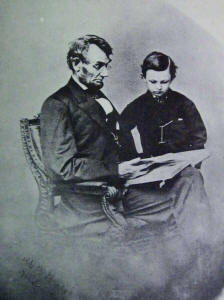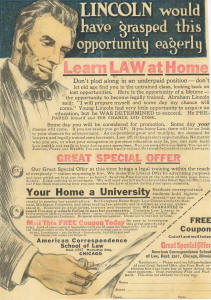| |
|

|
Table
of Contents
Home
Slavery
& Race
The South
Visual
Representations
Memorials
& Appropriations
Slavery
& Race
Sarah
Henderson
Joe Levell
Dan Haller
Nick
Schradle
The South
Dean DeChiaro
Steve Schaffer
Rick Ramirez
Visual
Representations
Alana Lemon
Jon Ingram
Peter Fúster
Aaron Stanton
Memorials
& Appropriation
Charles
Bennett
Molly Storer
Emma
Thorne-Christy
Visit Other Online
Exhibits
|
Abraham
Lincoln -- "Honest Abe," "the
Great Emancipator," country
lawyer, common man, preserver of
the Union, tragic and melancholy
loner. The students in the
Fall 2010 History 395: Lincoln's
Legacies course,
taught by Jeremiah B.C. Axelrod,
explored the strange and
convoluted trajectory of
Lincoln's identity through the
last century and a half of
American history, focusing not
so much on the "truth" of the
man as on the ways so many
Americans have appropriated
Lincoln's memory over the
decades.
Over the course of the fall
semester the class visited Oxy's
Special Collections department
to select and examine
representations of Abraham
Lincoln in texts and images in
the F. Ray
Risdon Lincolniana Collection,
which offers an array of books,
pamphlets, documents and
ephemera about and related to
Abraham Lincoln. Their
observations, commentary, and
analysis presented below, offer
insight into Lincoln in American
history as well as enhance the
descriptive record for each
work. The online catalog records
for these primary resources will
link to these analyses so as to
offer extended descriptions of
the texts for other researchers.
About this
Project / Acknowledgements
|
|
Slavery
& Race
In
the wake of the Civil
War, the ideology of
reconciliation stressed
the similarities between
the North and South
while ignoring the
underlying issues that
caused the conflict. The
following documents were
all written in the 20th
Century, and qualify as
retrospective
evaluations of slavery
and race as they pertain
to President Lincoln.
These documents also
offer a diverse
collection of
perspectives about the
status of African
Americans during and
after the Civil War.
Although Lincoln’s true
feelings regarding the
issue of slavery and
race are controversial,
there is clear evidence
of an evolution in
Lincoln’s views of
slavery and race over
time. Each of the
authors emphasize
different stages in the
evolution of Lincoln’s
views in order to frame
their own particular
arguments about the role
of race in American
society. Due to this
variance, all of these
documents pose at least
partially — and
sometimes completely —
conflicting accounts of
Lincoln’s attitude
toward African
Americans.
Only one of the
documents, written by
white supremacist
Earnest Cox, completely
embodies the ideal of
reconciliation. Cox does
so by fixating on the
evidence of Lincoln's
preference for the
colonization of African
Americans during the
first years of his
presidency — a racist
sentiment that
undermines the legacy of
emancipation and
bolsters the
conciliatory idea that
the war was fought
primarily for saving the
Union. The other
documents engage, and
partially or completely
contradict, this
ideology. Another white
supremacist,
Neo-Confederate Giles B.
Cook, argues that
Lincoln's motivation for
emancipation stems from
his aspirations for
personal glory. This
sentiment undermines
Lincoln’s legacy but
does not fully embody
the spirit of
reconciliation. The
other documents directly
challenge reconciliation
by focusing on the
legacy of emancipation
and expressing Lincoln’s
centrality in its
deliverance. In the
pamphlet “The Slavery
Atmosphere of Lincoln’s
Youth,” Louis A. Warren
argues that the
anti-slavery social
climate of Kentucky, and
Lincoln’s personal
encounters with slavery
in adolescence,
engendered his empathy
for the plight of slaves
and culminated in the
Emancipation
Proclamation. Finally,
African American scholar
Robert Moton’s pamphlet,
“The Negro's Debt to
Lincoln,” emphasizes
Lincoln’s role as the
Great Emancipator of the
African-American people.
While American culture
was tempted by
reconciliation in the
decades following
Reconstruction, these
documents show that
disparate ideologies,
grounded in
egalitarianism and white
supremacy, challenged
this dominant ideology.
Earnest
Sevier Cox
“Lincoln’s Negro
Policy”
Sarah
Henderson
|
The South
The
exploration texts of
Jefferson Davis, Edward A.
Pollard, and Francis
Wilson demonstrate a large
array of southern
remembrance and sentiments
of the Civil War and
President Lincoln in the
following decades. In
these texts there is an
increasing tone of
justification of the war
for the southerners as
well as swaying the war in
favor of the confederacy.
This confidence and
justification is begins
with Jefferson Davis’s
The Rise and Fall
of the Confederate
Government
when Davis concludes that
Lincoln and the federal
government were nothing
more than tyrants and the
confederacy was merely
exercising its
constitutional rights.
Similarly, former
Richmond Examiner
publisher, Edward A.
Pollard runs on the
foundation President Davis
laid out and attempts to
objectively re-write the
history of the war from a
Southern perspective.
While attempting to
redirect public memory of
the South throughout the
novel, Pollard even went
as far as to say that
Gettysburg was a victory
for the South. Pollard
also strategically omits
any mention of President
Lincoln’s assassination.
Finally, Francis
Wilson provides a face and
back-story to Lincoln’s
killer, John Wilkes Booth.
Leading with a Booth
quote, “Our country owed
all her troubles to him,
and God simply made me the
instrument of his
punishment"[1], Wilson
identifies Booth as a
“Lost Cause” fanatic.
Wilson believes that Booth
was a spotlight-seeking
assassin who thought he
would become a staple in
Southerners memory of the
Civil War.
These three prime
examples of the south’s
memory of the Civil War
and Lincoln, display a
common theme of southern
moral victory in the face
of a great tyrant. This
view helped many veterans
and natives of the South
to rationalize the war’s
outcome and the post war
era.
These examples
can also certainly be
paired with David W.
Blight’s Race and Reunion,
in which the author
touches on the tradition
of the Lost Cause and how
reconciliation could stem
from the Southern ideology
by separating slavery from
the cause of the Civil
War. Blight recalls a
speech given by Robert E.
Lee’s grandson delivered
in 1911, where he
suggested, “If the South
had been heeded, slavery
would have been eliminated
years before it was. It
was the votes of the
southern states which
finally freed the
slaves.”[2] By twisting
the history and using this
strange logic, Lost Cause
believers could not be
absolved from the
responsibility of slavery
but also made them true
abolitionists. As Blight
put it, “Protected by such
mists of sentiment, the
past could be anything
people wished.”[3]
Finally, the idea the
notion created by Lost
Cause members that even
when Americans lose, they
win. This indomitable
spirit, that Margaret
Mitchell infused into her
character Scarlett O’Hara
in Gone with the
Wind (1936), and such
is the basis of the
enduring legend of Robert
E. Lee—through noble
character,
he won by losing.[4]
Francis
Wilson "John
Wilkes Booth: Fact
and Fiction of
Lincoln's
Assassination"
Dean
DeChiaro
Edward
A. Pollard "The Lost
Cause: A New
Southern History of
the War of the
Confederates"
Steve Schaffer
Jefferson
Davis "The Rise and
Fall of the
Confederate
Government"
Rick Ramirez
[1] Wilson, Francis.
John Wilkes
Booth: Fact and Fiction of
Lincoln's Assassination, 1st ed.
(Boston: Houghton Mifflin,
1929) pp. xv.
[2] Blight, David W.
Race and Reunion,
The Civil War in
American Memory, (Harvard
University Press, 2001)
pp. 283.
[3] Ibid., pp. 283.
[4] Ibid., pp. 284.
Return to Top
|
Visual
Representations

From a young Kentucky
rail-splitter to the
savior of the Union,
visual portrayal of
Abraham Lincoln remains
a national obsession for
most Americans. Having
lived in the era that
witnessed the birth of
the camera, Lincoln
remains one of the most
formally photographed
U.S. presidents. These
numerous images from his
life have been the basis
for increasingly diverse
artistic renderings of
this beloved figure.
The range of these
representations, from
romanticized paintings
of his Gettysburg speech
to George Grey Barnard's
controversial Lincoln
sculpture in Cincinnati,
exemplifies the
diversity of Lincolnian
mythology. Visual
representations are one
way in which various
individuals and groups
have appropriated the
life and legacy of the
president in order to
lend validation to their
respective causes. Thus
an analysis of differing
depictions of Lincoln
allows the viewer to
identify what aspect of
Lincoln the artist has
chosen to emphasize,
valorize, or even
disparage.
Elmer
Harland Daniels
"Apotheosis", Nancy
Hanks Lincoln
Memorial
Alana Lemon
“Honest Old
Abe . 30 Years Ago”
Poster
Jon Ingram
Photograph
of Abraham and Tad
Lincoln
Peter Fúster
“Attained”
Cartoon from “London
Fun”
Aaron Stanton
Return to Top
|
Memorials
& Appropriation
 Our
study focuses on
commercial
appropriations of
Lincoln’s name, image,
and values. In
keeping with this aim,
we have selected
several commercial
advertisements dating
from roughly 1900 to
1950. All these
advertisements were
produced by companies
located in
historically Union
states, particularly
from areas with large
numbers of
Midwesterners who held
a strong reverence of
Lincoln. It is
presumed that both
producer and consumer
for most of the
advertised products
and companies viewed
Lincoln positively.
There is an
expectation on the
part of the advertiser
that everyone likes
Lincoln, the effect of
reconciliation. A
reconciliationist
narrative produced a
Lincoln image devoid
of historical fact.
These advertisements
are vacuous in that
they are void of any
real content. They
fail to acknowledge
Lincoln’s
controversial role in
the Civil War and
ending slavery. The
lack of controversial
content pertaining to
Lincoln make these
commercial
representations
unobjectable,
effective in their
ambiguity. Our
study focuses on
commercial
appropriations of
Lincoln’s name, image,
and values. In
keeping with this aim,
we have selected
several commercial
advertisements dating
from roughly 1900 to
1950. All these
advertisements were
produced by companies
located in
historically Union
states, particularly
from areas with large
numbers of
Midwesterners who held
a strong reverence of
Lincoln. It is
presumed that both
producer and consumer
for most of the
advertised products
and companies viewed
Lincoln positively.
There is an
expectation on the
part of the advertiser
that everyone likes
Lincoln, the effect of
reconciliation. A
reconciliationist
narrative produced a
Lincoln image devoid
of historical fact.
These advertisements
are vacuous in that
they are void of any
real content. They
fail to acknowledge
Lincoln’s
controversial role in
the Civil War and
ending slavery. The
lack of controversial
content pertaining to
Lincoln make these
commercial
representations
unobjectable,
effective in their
ambiguity.
We
found several
commonalities between
the various pieces in
our exhibit.
Almost all the
appropriations depict
Lincoln in his bearded
Presidential years
(except the writing
tablet that has
illustrations of
Lincoln throughout his
life). All the
appropriations depict
Lincoln in a favorable
light, a light that
would also cast favor
upon the products
being sold. We
have concluded, given
that these are all
advertisements from
newspapers and fliers,
that these depictions
of Lincoln were
intended for mass
consumption and wide
distribution. While
the overarching motive
behind the Lincoln
advertisements is to
sell a product, many
also suggest America’s
take on Lincoln’s
“values” to their
audience. Some
of the more prevalent
values include honor,
honesty, hard work,
humanism and homage to
American values of
patriotism and
freedom. These
values are used to
link the business
practices of the
company and their
products to Lincoln.
J.C. Blair
Company “Lincoln
Axiom Tablet” and
Advertisement for
Lincolns Savings and
Loan
Charles Bennett
Advertisement
from "The Lincoln
National Insurance
Company" and
"Lincoln on Private
Property"
Molly Storer
“Lincoln
Would Have Grasped
This Opportunity
Eagerly”Advertisement
for The American
Correspondence School
of Law, and
“Furniture
Fashions—The Rugged
Honesty of Lincoln”
from
The Peck
& Hills Furniture
Co.
Emma Thorne-Christy
Return to Top
|
|
| |
About
this Project / Acknowledgements
Occidental
College's "Lincoln Legacies"
Research Seminar was developed by
Dr. Jeremiah B.C. Axelrod, Adjunct
Assistant Professor of History.
The library project
is developed in collaboration with
the Special Collections
Department:
Dale Ann Stieber, Special
Collections Librarian with student
staff
Alana Lemon and Brittany Todd.
The F. Ray Risdon Lincolniana
Collection (ca. 4,000 volumes) is
the result of a fascination with
Abraham Lincoln and the Civil War
by Los Angeles lawyer and
collector, F. Ray Risdon.
Acquired by the
library in 1956, this historical
resource focusing on Abraham
Lincoln and the Civil War is
especially rich in contemporaneous
materials from the Civil War
period as well as documents,
realia, posters, photographs and
ephemera memorializing Abraham
Lincoln.
|
|
Page last edited on 03/12/2013.
Occidental
College Library Special
Collections & College
Archives
© 2010 Occidental College |
|
|
|